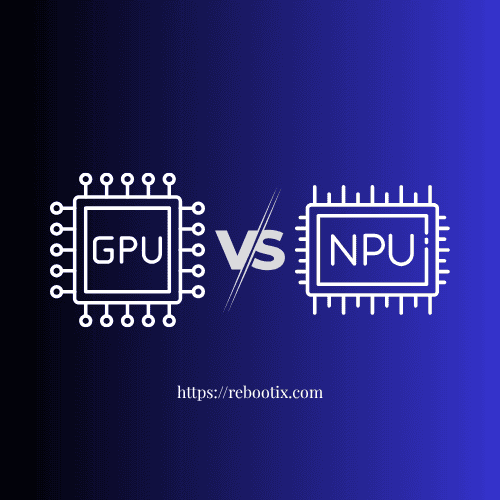Is NPU Better Than GPU?
There is a typical question in the sphere of artificial intelligence (AI):
“Which is superior, NPU or GPU? What is superior when it comes to AI processes such as machine learning, deep learning simulations, and real-time AI calculations?”
In case you are attempting to decide on what hardware to utilize in your AI endeavours, this guide will take you through the distinctions between NPUs (Neural Processing Units) and GPUs (Graphics Processing Units), and get you on the right path with regards to your requirements.
NPU or GPU: What is the Difference?
It is beneficial to understand the capabilities of each processor before making a comparison.
NPU (Neural Processing Unit): What is it?
An NPU is a specialized processor aimed at increasing the speed of applying and processing AI inferences, such as:
- Image recognition
- Voice detection
- Real-time translations
- Smart features on the device
Modern smartphones, Internet of Things gadgets, and certain high-end computers all have NPUs. Those are designed to implement AI in a power-efficient manner, using minimal power.
What is a GPU ( Graphics Processing Unit)?
Developed to display images and video, GPUs have recently gained popularity as a method to train AI because of their capacity to handle thousands of tasks in parallel. They are great:
- Big data processing
- AI research
- Video rendering and Games
Is NPU Better Than GPU for AI Tasks?
| Feature | GPU (Graphics Processing Unit) | NPU (Neural Processing Unit) |
|---|---|---|
| Main Purpose | Graphics + AI model training | AI inference and real-time processing |
| Best For | Training large AI models | Running AI models efficiently |
| Power Usage | High (desktop and server use) | Low (ideal for mobile and edge devices) |
| Inference Speed | Fast | Optimized for speed and power efficiency |
| AI Accuracy | High with high resource consumption | Balanced with low energy use |
| Price | Expensive | Cost-effective and integrated |
When Would You Want to Use an NPU, Compared to a GPU, as Microsoft Does?
In case you want to execute AI programs running in real-time, including:
- Facial recognition on a device
- Smart photography
- Voice processing
- Language translation
- Offline AI help
In this case, NPU is more appropriate for such inference-based tasks than a GPU. NPUs are meant to be lightweight and local AI operations that do not use cloud servers.
In what cases is a GPU more effective, like AI, than an NPU?
When you have undertaken:
- The training of deep learning massive models
- Building AI models is a blank canvas.
- The development of AI systems on a cloud basis
- Computing AIs that are resource-heavy
Conclusion: Is NPU Better Than GPU?
| Use Case | Recommended Processor |
|---|---|
| Training large machine learning models | GPU |
| Real-time AI tasks on mobile or edge devices | NPU |
| Developing AI on PC or cloud infrastructure | GPU |
| Power-efficient smart features | NPU |
FAQs
1. Can NPU replace GPU?
No, NPU will not replace GPUs completely. Although NPUs are best suited to executing AI inference processes, they require collaboration with GPUs to conduct AI training of complex models and large-volume data processing. The two have different applications in the AI ecosystem.
2. What are the main disadvantages of NPU?
NPUs have some of the following drawbacks:
- More restrictive to certain tasks of AI (pretty much inference)
- Inappropriate Investing by AI training/ heavy load
- Not as general-purpose as GPUs in computing
3. Does NPU lead to enhanced performance?
Yes, NPUs are capable of greatly increasing AI inference performance with higher throughput and, at the same time, consume less power. They enable the mobile and embedded technology to be used to execute real-time AI functions.
4. Even when I have a GPU, do I require an NPU?
It depends. You can also achieve a more efficient NPU than a GPU when working on AI, especially if it needs to be run in real-time on devices. But a GPU will do the trick in most of the desktop applications or training of an AI model.
5. What processor is ideal for mobile AI?
NPU has a higher potential in mobile AI computation since it works in low-power, high-end inference on the machine, not requiring cloud connectivity.
6. Is it possible to train AI on an NPU?
Nope, NPUs do not work with AI models in mind. Mostly, they are used when you have already-trained models (inference). GPUs or TPUs (Tensor Processing Units) should be utilized to ensure training works.



